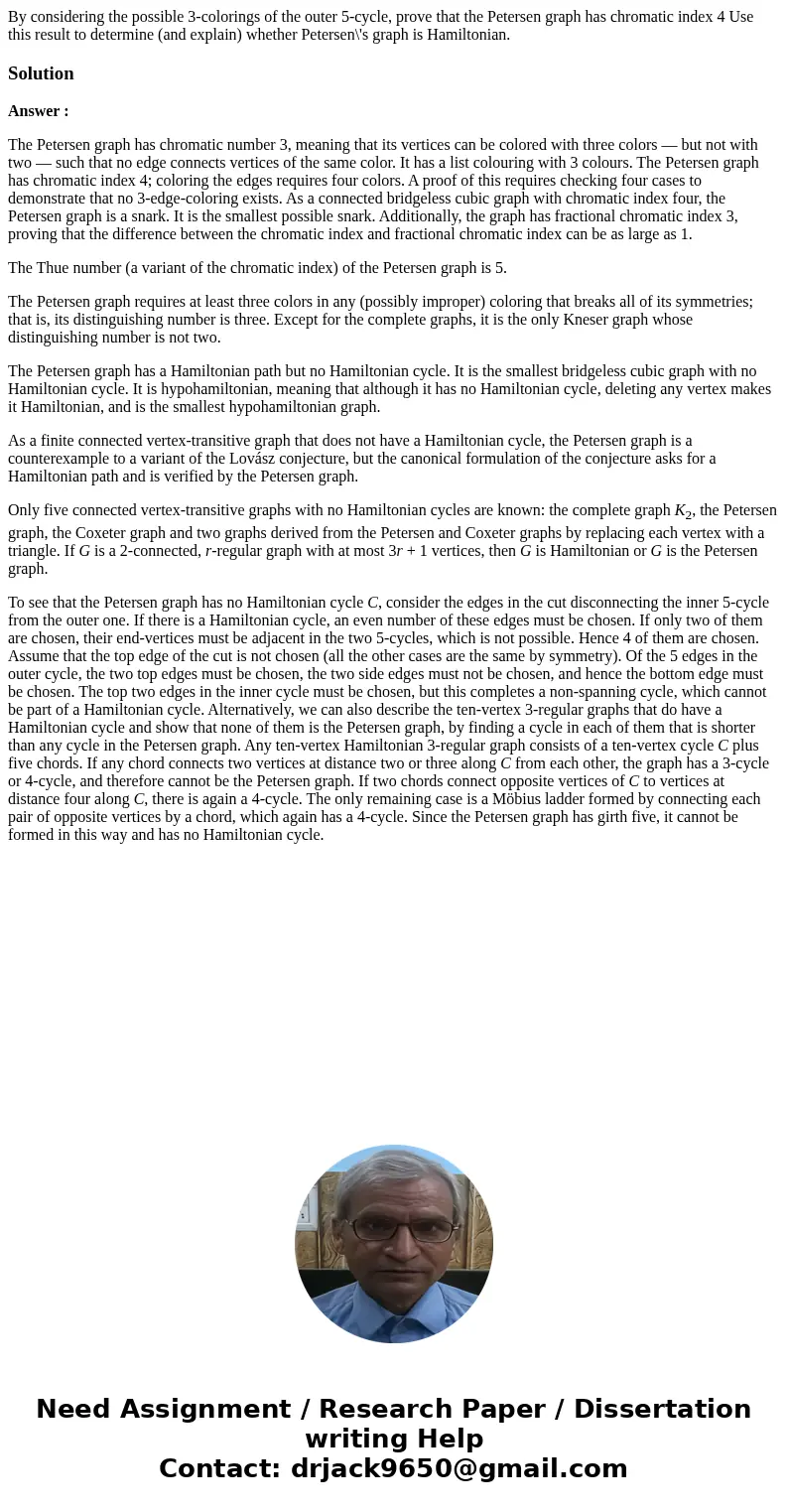By considering the possible 3colorings of the outer 5cycle p
Solution
Answer :
The Petersen graph has chromatic number 3, meaning that its vertices can be colored with three colors — but not with two — such that no edge connects vertices of the same color. It has a list colouring with 3 colours. The Petersen graph has chromatic index 4; coloring the edges requires four colors. A proof of this requires checking four cases to demonstrate that no 3-edge-coloring exists. As a connected bridgeless cubic graph with chromatic index four, the Petersen graph is a snark. It is the smallest possible snark. Additionally, the graph has fractional chromatic index 3, proving that the difference between the chromatic index and fractional chromatic index can be as large as 1.
The Thue number (a variant of the chromatic index) of the Petersen graph is 5.
The Petersen graph requires at least three colors in any (possibly improper) coloring that breaks all of its symmetries; that is, its distinguishing number is three. Except for the complete graphs, it is the only Kneser graph whose distinguishing number is not two.
The Petersen graph has a Hamiltonian path but no Hamiltonian cycle. It is the smallest bridgeless cubic graph with no Hamiltonian cycle. It is hypohamiltonian, meaning that although it has no Hamiltonian cycle, deleting any vertex makes it Hamiltonian, and is the smallest hypohamiltonian graph.
As a finite connected vertex-transitive graph that does not have a Hamiltonian cycle, the Petersen graph is a counterexample to a variant of the Lovász conjecture, but the canonical formulation of the conjecture asks for a Hamiltonian path and is verified by the Petersen graph.
Only five connected vertex-transitive graphs with no Hamiltonian cycles are known: the complete graph K2, the Petersen graph, the Coxeter graph and two graphs derived from the Petersen and Coxeter graphs by replacing each vertex with a triangle. If G is a 2-connected, r-regular graph with at most 3r + 1 vertices, then G is Hamiltonian or G is the Petersen graph.
To see that the Petersen graph has no Hamiltonian cycle C, consider the edges in the cut disconnecting the inner 5-cycle from the outer one. If there is a Hamiltonian cycle, an even number of these edges must be chosen. If only two of them are chosen, their end-vertices must be adjacent in the two 5-cycles, which is not possible. Hence 4 of them are chosen. Assume that the top edge of the cut is not chosen (all the other cases are the same by symmetry). Of the 5 edges in the outer cycle, the two top edges must be chosen, the two side edges must not be chosen, and hence the bottom edge must be chosen. The top two edges in the inner cycle must be chosen, but this completes a non-spanning cycle, which cannot be part of a Hamiltonian cycle. Alternatively, we can also describe the ten-vertex 3-regular graphs that do have a Hamiltonian cycle and show that none of them is the Petersen graph, by finding a cycle in each of them that is shorter than any cycle in the Petersen graph. Any ten-vertex Hamiltonian 3-regular graph consists of a ten-vertex cycle C plus five chords. If any chord connects two vertices at distance two or three along C from each other, the graph has a 3-cycle or 4-cycle, and therefore cannot be the Petersen graph. If two chords connect opposite vertices of C to vertices at distance four along C, there is again a 4-cycle. The only remaining case is a Möbius ladder formed by connecting each pair of opposite vertices by a chord, which again has a 4-cycle. Since the Petersen graph has girth five, it cannot be formed in this way and has no Hamiltonian cycle.

 Homework Sourse
Homework Sourse